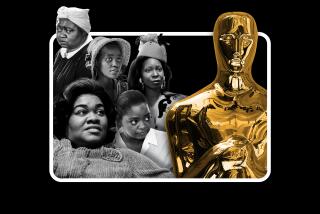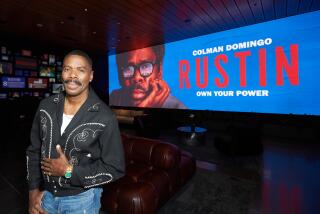Follow us wherever you get your podcasts:
In her first audition for the role of Anita in Steven Spielberg’s “West Side Story,” Ariana DeBose stressed the importance of having her identity represented. “If you aren’t interested in reflecting that in the context of your script,” she told the acclaimed director, “I don’t think that you should hire me.” The result is a far cry from the “ethnically ambiguous” characters DeBose has portrayed in the past, and she is now the first Afro Latina and the first queer woman of color to be nominated for an acting Oscar. In this interview, DeBose details the most joyful (and harrowing) moments of shooting “West Side Story,” her experience of being typecast in Hollywood, and why — despite initial hesitance — she ultimately decided to follow in Rita Moreno’s footsteps by starring in the remake.
Mark Olsen: Hello! I’m Mark Olsen.
Yvonne Villarreal: And I’m Yvonne Villarreal. You’re listening to “The Envelope,” the L.A. Times podcast where we go behind the scenes with your favorite stars from TV and film.
Olsen: Our guest today is nominated for an Oscar in the best supporting actress category — and it’s for a role that has already earned another actress the same award back in 1962. And — now, Yvonne, stay with me here — that person who won the Academy Award back in 1962? She wasn’t even the first person to play the character.
Villarreal: Interesting riddle, Mark. Tell me more, please.
Olsen: Oscar history, I tell ya. OK, let me explain. I’ll start in 1957. The original “West Side Story” premiered on Broadway, and Chita Rivera was the first person to play the now-iconic role of Anita.
The musical was a huge success, and a film adaptation followed in 1961. The legendary Rita Moreno played Anita in that version, and she won the Academy Award for best supporting actress.
Which brings us to today’s guest: Ariana DeBose. For her fresh and distinctive take on Anita in Steven Spielberg’s adaptation of “West Side Story,” Ariana has made history as the first Afro Latina and openly queer woman of color to be nominated for an acting Oscar.
[Clip from “West Side Story”: ANITA: You want to know where my home is? It’s where I pay rent. Right here, where I work my fingers raw mending pants and hemming neckties so that I can earn enough money to pay other girls to sew for me so that someday I can rent a shop of my own in this great big beautiful Nueva York!]
Olsen: You may have known Ariana already as the Bullet in the original production of “Hamilton” or Disco Donna in “Summer: The Donna Summer Musical,” and though she didn’t see herself starring in “West Side Story” — and, as she’ll say, it even took her some convincing — she now sees it as a role she was destined to play:
DeBose: My earliest memories are watching the film in my grandmother’s living room, and I was enamored with the woman in the purple dress. Now, it wasn’t until my adulthood that I even began to understand the story and what she was dancing about, or what she was speaking about, or just in general, what was happening in the film. And then it took even longer for me to realize, “Oh, it was a stage musical before,” which I think is fascinating considering I’m a “Broadway baby.” But when I finally moved to New York, I was 18 years old, and “West Side Story” very much became a part of my education. You know, I trained with many professionals, dancers, mentors who are steeped in “West Side” legacy, steeped in the Jerome Robbins choreography. So I became fairly well acquainted with it, with the great existence of Chita Rivera. I found her incredibly inspiring, still do to this day. So you couple that with the knowledge and my love for Rita Moreno from a young age, and while I won’t say that I am a “West Side Story” devotee, I am an ardent admirer of these women, and I found them incredibly inspiring.
Olsen: “West Side Story” casting director Cindy Tolan has talked about how she really pursued you for the part of Anita, that she asked you four times to audition and you initially don’t want to do it. Tell me about that. What was it that made you not want to do it at first?
DeBose: You know, it’s so funny. I don’t remember it that way, but I know she’s telling the truth. I was hesitant to go in for many reasons. Latinas in the industry don’t really look like me — or hadn’t — and roles like this had not really been manifested in Black Latinas — not for nothing. I also was hesitant because I was like, “Do we need to tell this story again?” And then ultimately the answer for me was, well, if I was going to do it, I would want to give it a new perspective, and my being gives it a new perspective. My Afro Latinidad, my heritage, my lived experience as a Black woman can give this something new, maybe something we’ve yet to see. But I also questioned whether there was space for that. I mean, Rita Moreno won an Academy Award for her portrayal. She is a legend in her own time, and her portrayal is beloved. So I questioned whether or not there was space for me.
Olsen: Well, I want to talk about that a little more, especially this notion of wanting the role to reflect your identity as an Afro Latina woman. As I understand it, you sort of said to Steven Spielberg and Tony Kushner that you wanted the role to reflect that. What is that conversation like? I mean, those are two people who know a thing or two about storytelling. Where do you get the courage and the ability to sort of stand up for yourself, your whole self in that?
DeBose: You know, I think the spirit just caught me. I must’ve eaten my Wheaties that day or something because I don’t know where it all came from. It just started falling out of my mouth, and I felt very bold in that moment. But I can tell you that I was raised by an incredibly strong woman. My mother was a single parent, and she’s a public school teacher. She raised me to speak my mind respectfully and to have great love for where you come from and also be determined about the direction you want to go and then just go for it. So perhaps my upbringing was sort of leading the charge there, maybe?
Olsen: And were they receptive to this notion? Like, how did that conversation go in the room?
DeBose: Well, it was that first day that I had met Steven. I danced, and he enjoyed my dancing. He asked me to sing, he enjoyed my singing. Then we got to the acting portion, and he asked me if I would read. And I said, “No.” And he said, “No?” And Cindy Tolan chimed in and was like, “No, we spoke about Ariana. She just would like more time to be prepared.” Because I had said to Cindy the night before that these are Tony Kushner expanded scenes. They were a bit wordy, and I didn’t feel like I had enough time to actually prepare. And given my experience as a woman of color, you don’t walk into these rooms unprepared. Otherwise they don’t take you seriously, and sometimes you don’t get another chance. So I said no, and she backed me up, and he said, “You won’t read today, but will you come back another time?” And I said I would be honored. Then he asked if there was anything else that he should know, and that’s when my mouth just started moving. And I said, “You know, I would be the darkest woman to play this, or at least this role onscreen. And if you aren’t interested in reflecting that in the context of your script, in the context of this storytelling, then I don’t think that you should hire me.” Because — well, I didn’t say this part in the room, but the point of that statement was — Afro Latinas are very frequently erased from the conversation around Latinidad or Hispanic heritage. There are facets of our community that really erase that lived experience because it was preferred for you to have lighter skin.
Olsen: I understand that prior to production you were not fluent in Spanish. So on top of all the other work that you’re doing for this role, you’re also learning Spanish?
DeBose: Yes, I’m still not fluent. I can hold my own, but I conduct absolutely no interviews in Español because I get nervous. I forget everything. I don’t believe in speaking it badly, so for some odd reason, it was easier for me to step into the shoes of Anita and speak Spanish. But as Ariana, I struggle, and I don’t like representing the language poorly. It’s something I still practice to this day.
Olsen: Was that something that had ever come up before? Did people assume that you spoke Spanish, or was it ever an issue for you that, prior to this, that you didn’t speak Spanish fluently?
DeBose: Okay, Mark, let’s talk about it. I took Spanish in high school. For the longest time, it was assumed that I was African American, and no one ever really asked me how I identified. And then when I did ask to be seen for Hispanic roles, even English-speaking Hispanic roles — whether on Broadway or in the film and television realm — nine times out of 10, I was told I was too Black to be considered Hispanic. So honestly, “West Side Story” is the first time I’ve ever been considered for a role that is something I actually am. I am Puerto Rican. My father is Puerto Rican. I’m a mixed-race human being. I am Afro Latina, and I’m Puerto Rican. Isn’t that interesting?
Olsen: Yeah, that’s wild that this is the first time that you’ve portrayed a Latina character.
DeBose: Well, the first — I think I played a character named Nautica in “Bring It On: The Musical,” and if I am correct, it was never specified that she must be Hispanic. Over time the character just became whatever she was. The term ethnically ambiguous comes to mind. I now hold the belief that that can be a very damaging term, and I would love it if we would stop using it.
Olsen: How so?
DeBose: Well, I think saying ethnically ambiguous is different than saying there is no specific ethnicity for this character. Come in and portray what is on the page. Ethnically ambiguous to me is gray. And as someone with a lived experience that feels like [it] has been relegated to the gray, it’s not something that is given light. We don’t shine light on gray. In my professional experience, anytime I saw a character that lent itself toward ethnic ambiguity, it meant they were a sidekick and they were not really integral to the plot, and that bothers me. To me, there are no small parts; every part matters. So why not just say, “Ethnicity is not specific to the portrayal of this character. Come in with an idea.”
Olsen: I want to ask about some specific scenes and moments in the movie, starting with the “America” number.
[Clip of “America” from “West Side Story”: Life can be bright in America / If you can fight in America / Life is all right in America / If you’re all white in America.]
Olsen: It’s a much more contained number in the earlier film, and here it’s such a centerpiece, almost like a statement of purpose for this new adaptation. How did you feel about the way that the song and that sequence is used in the movie?
DeBose: Oh, I love it. I think the choice to take “America” off of the rooftop and into the streets, into the community, was so smart because it allows the audience, it allows the viewer to get to know the community and some of the things that are actually going on, some of the challenges they are facing. You actually get the sense that they are being pushed out, and you get the varying perspectives around that. Anita is very clearly like, “They’re going to build a new building. We can have a better place to live.” Whereas there are many folks who are like, “They’re not building this building for us though.”
[Clip of “America” from “West Side Story”: (Singing) Lots of new housing with more space / Lots of doors slamming in our face / I’ll get a terrace apartment / Better get rid of your accent.]
DeBose: So I think it was an important choice to make because it also allowed for even deeper conversation, not only between Anita and Bernardo, but amongst the community.
Olsen: And what was it like shooting that number [with the] choreographer? Justin Peck said the soles of your shoes literally melted from the heat of New York City but also the intensity of the work?
DeBose: Yes, they did.
Olsen: That’s incredible.
DeBose: Yeah, people have said, “Gosh, she just doesn’t stop spinning,” and you’re right. Antia spins and spins and spins, and ultimately those beautiful pirouettes are exactly why and how I burned holes in my shoes. We shot “America” over the course of a month and during a heat wave. And not only was there a heat wave, but Janusz Kamiński, our incredible director of photography, decided that, not only was it hot, but he needed to add more lights. So, pull in the football-stadium-sized lighting, and also it’s 107 degrees, and go. I still have tan lines from making that movie.
Olsen: I want to be sure to ask you about the drugstore scene, when Anita goes to see Valentina and she has this run-in with the Jets game. They attack her. They nearly rape her. That moment is extremely intense and unsettling.
[Clip from “West Side Story”: A-RAB: Come on, ya pig, let’s see your moves! SNOWBOY: Bernardo’s Black pig.]
Olsen: For anyone who thinks that musical theater is all lightness and romance, that scene on its own shows that there’s so much more to musical theater.
[Clip from “West Side Story”: VALENTINA: Oh, my God! Oh, my God! What the hell are you doing, you disgusting pieces of shit?!]
Olsen: What was it like for you, shooting that scene in particular?
DeBose: It was a tough 48 hours. Everyone was highly uncomfortable. That’s a scene where I think separation of church and state, quote unquote, separation of reality from the circumstances that you are playing is very important. Ariana and her relationship to these wonderful young men, very different relationship than what Anita is experiencing with the Jets. Thankfully we had an incredible intimacy coordinator who helped us come up with safe words. We had very good boundaries so we could keep everyone safe and working efficiently and respectfully. So I think it does a compelling job of showing just how horrifying gang rape is and putting yourself in Anita’s shoes, seeing just how horrifying it can be when 12 men look at you with extreme intent to harm your person.
Olsen: And shooting that scene with Rita Moreno there, I can only imagine what that must have added sort of emotionally to the moment. And then simply the fact that also Anita gets angry with Valentina:
[Clip from “West Side Story”: ANITA: ¡Yo no soy tu hija, traitor! Tú les das techo a estos puercos.]
Olsen: To portray anger toward Rita, it must have been a challenge.
DeBose: Oh, of course. Highly uncomfortable. There was no way in the world that Ariana DeBose wanted to shout at Rita Moreno. That was not a thing that she wanted to do. But Anita needed to shout and lash out at Valentina. It was important to the version of this story that that moment happened because it speaks to, you know, the different life experiences of these two Latinas. It speaks to the generational divide. And I find Valentina so interesting as a character because she’s so clearly “He thinks it makes me a gringa, but I don’t, and I ain’t,” and yet she actively allows these boys to hang out in her shop, and she gives them safe harbor, even though they commit incredible atrocities against her people, her community. It’s fascinating.
Olsen: Rita Moreno, as you said, she won an Oscar for this role in the 1961 film. She’s an executive producer and she’s in the new film. What was it like having her around? Was she watching you? Was she sort of supervising your performance in a way?
DeBose: No. She by no means supervised my performance, but it was lovely and strange to have her there. I will say when Steven called to offer me the job — How cool is that? What old-school class. He calls to offer you a job. That’s so nice — I, in my naivete, did not realize that Rita was in the film or executive producing. I think I was just so excited that I’d been offered the job that I missed those tiny details, or perhaps they hadn’t been shared with the world yet. I can’t quite remember which, but it wasn’t something that I felt I was fully cognizant of as a reality until we were in the same room together. I had the opportunity to share time and space with a legend, and not only was she nice to me, she empowered me to speak up for myself, speak my mind, advocate for not only myself but for others. I just think she’s the bee’s knees.
Olsen: You mentioned earlier that you asked yourself this question of “Why even do this new version of the story?” My colleague at The Times Ashley Lee wrote powerfully about how the issues of representation in “West Side Story,” to some extent, can’t be solved, that they’re sort of too deep-rooted in the creation of the original text created by this group of white men, so that the depiction of Puerto Rican life was always going to be inauthentic. How did you grapple with those questions yourself? How did you answer the question of “Why make this film?”
DeBose: Well, I think it’s twofold. I think she has a valid opinion and a valid perspective. For me, “West Side Story” is still a musical, and as a professional who has worked on Broadway for a decade-plus, I’ve never seen a musical that is 100% based on fact. Absolutely not because otherwise you lose this otherworldly element of it, but that doesn’t mean that you can’t strive to root it in reality. And for me, once I had spoken with Steven and Tony and realized their commitment to doing their best, to representing Hispanic culture, to the best of their ability, from the point of admitting that they are two white Jewish men, and there’s no way they could possibly understand that lived experience. They humbled themselves, and they went to the University of Puerto Rico to speak to the community, to ask what their grievances were, so that they could try to do better than what was done before. For me, that is several steps in the right direction, because that is not what is done every day.
Olsen: Tony Kushner said how he wasn’t trying to fix the play. He didn’t want to be in competition with the 1961 film. In some ways, I’m wondering if you approach this almost as if it was a production of “Hamlet” or something, in that you can approach this text as a classic work. So you want to bring whatever modern sensibility or whatever you all can bring to this text, by doing it again today.
DeBose: Absolutely. I love that you referenced Shakespeare because I have also referenced Shakespeare. We don’t complain as an industry that people [make] multiple productions of Shakespeare or re-imagine it. Nobody is complaining that “King Lear” was done with a completely diverse cast or set in a different time period. We don’t complain about that. So what’s the difference? I don’t see the difference. So that’s why I say there was no need for me to go and study the 1961 film, the Robert Wise film, because it had already been done. The only reason for us to approach this work was to see what we could do in service of offering a different perspective on a text that is a classic.
Olsen: I have to ask, do you feel like it’s fair that you, Rachel Zegler, even Rita Moreno, are the ones that have to answer all these questions about representation in the film, as opposed to say the original creators or — I mean, Tony and Steven have addressed it. But is it frustrating ever that you’re sort of set up as like the face and kind of the voice of the project?
DeBose: What a loaded question. Oh, I love you for that, Mark. I don’t necessarily think that it’s always fair because sometimes I feel like I’m put in the position to have to defend this work. The work speaks for itself. Period. Point blank. End of story. I believe our message is so strong, and I think you see it in the faces of every single Hispanic on that screen. And it may not be fair that I’m asked to answer these questions, but if I can’t answer them, who can?
Olsen: Just in the past year, there are a number of other movie musicals besides just “West Side Story.” There was “In the Heights” and “Tick, Tick ... Boom!” and even a few others. As someone with so much experience on Broadway, is there a big difference between stage musicals and movie musicals?
DeBose: I don’t know if I can pinpoint the absolute distinction, but I can tell you there are very different ways of approaching them. I think understanding the nuance of a musical and the synergy, the moment where a character can no longer speak and they have to sing? For me, that is a really delicate thing in the context of movie musicals, because sometimes it can come off as like, “Oh, they’re done talking, and now they’re going to wait, and they’re going to sing a fun song now. Yay!” And that’s not really what it is. It’s a much deeper, emotional thing. You can capture it in great detail, and it can be so simple. But when it’s done really well, it feels like speech just turned into song.
[Clip from “West Side Story”: ANITA: ¿Pero qué es esto? MARÍA: I love him. ANITA (singing): A boy like that, who killed your brother? Forget that boy, and find another! One of your own kind. Stick to your own kind!]
Olsen: You’d been in a number of shows before you were in “Hamilton,” and as I understand it, your role of the Bullet sort of transformed a little as the show was being developed.
DeBose: Yeah.
Olsen: Was that role kind of a turning point for you? Do you feel like things — whether for you as a performer or just in your career — changed after “Hamilton” and because of “Hamilton”?
DeBose: I think the short answer is yes. What the Bullet started out as and what the Bullet became made me a better actor. It really showed me, and I was able to show myself that I could create an arc through movement and acting. And that there is a world where they exist and they are one and the same. “Hamilton” opened many doors just by virtue of having “Hamilton” on my résumé. I was able to be considered for some roles that I don’t feel like I would have even made it into the room for. I don’t think I would have been on anyone’s radar. Had they not said, “Who’s this girl from ‘Hamilton’? Oh, she’s the Bullet. What is that? Well, let’s bring her in and see what she does.” So, I mean, the answer is yes, it afforded me opportunity, but I had to go in and change people’s minds to show them that I could do something different as well.
Olsen: Before we wrap up, I want to just ask you, as someone who’s a real fan of musical theater, what does it mean to you being a part of “West Side Story,” to be able to put yourself into the heritage and the lineage of what that production means for the Broadway community?
DeBose: It means a great deal, and that is the long and the short of it. It means a great deal. I don’t know that I ever really realized what taking this job fully would mean in the macro of it, but it’s an honor to realize that my name will sit alongside Chita Rivera’s and Rita Moreno’s and Debbie Allen’s. It means a lot to have been given the opportunity to make a text so deeply steeped in Broadway legacy for the silver screen and to allow it to become part of the legacy because, at the end of the day, film lasts forever. That’s huge, and I don’t think I’ll fully process that for a very long time.
This episode was produced by Heba Elorbany and edited by Jazmín Aguilera. Our engineer and composer is Mike Heflin. Special thanks to Asal Ehsanipour, Shani Hilton, Clint Schaff, Tova Weinstock, Amy Wong, Chris Price, Ross May, Patricia Gardiner, Geoff Berkshire, Elena Howe and Matt Brennan.










